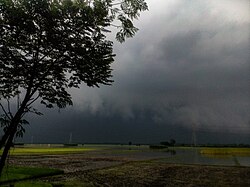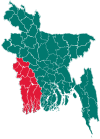Mirpur Upazila
Mirpur
মিরপুর (কুষ্টিয়া) | |
|---|---|
Upazila | |
 Village in Mirpur Upazila | |
 | |
| Coordinates: 23°56′N 89°0′E / 23.933°N 89.000°E | |
| Country | |
| Division | Khulna |
| District | Kushtia |
| Area | |
• Total | 305.06 km2 (117.78 sq mi) |
| Population | |
• Total | 363,106 |
| • Density | 1,200/km2 (3,100/sq mi) |
| Time zone | UTC+6 (BST) |
| Postal code | 7030[2] |
| Website | Official Map of Mirpur |
Mirpur (Bengali: মিরপুর (কুষ্টিয়া) is an upazila of Kushtia District in the Division of Khulna, Bangladesh.[3] Mirpur Thana was formed in 1885 and it was turned into an upazila in 1983.
History
[edit]Mirpur was listed in the Ain-i-Akbari as a mahal in sarkar Mahmudabad.[4]: 133 It was listed with an assessed revenue of 2,370 dams.[4]: 133
The former Mirpur Thana, which was formed in 1885 became an upazila on 1 August 1983.[3]
Geography
[edit]Mirpur is located at 23°56′00″N 89°00′00″E / 23.9333°N 89.0000°E. It has a total area of 305.06 km2.
The upazila is bounded by Bheramara and Ishwardi upazilas on the north, Alamdanga and Kushtia Sadar upazilas on the south, Kushtia Sadar upazila on the east, Daulatpur, Gangni and Alamdanga upazilas on the west.[3]
Demographics
[edit]As of the 2011 Census of Bangladesh, Mirpur upazila had 82,783 households and a population of 330,115. 64,533 (19.55%) were under 10 years of age. Mirpur had a literacy rate of 41.86%, compared to the national average of 51.8%, and a sex ratio of 994 females per 1000 males. 32,802 (9.94%) of the population lived in urban areas.[6][7]
At the 1991 Bangladesh census, Mirpur had a population of 266,046. Males constitute 51.76% of the population, and females 48.24%. The population aged 18 or over was 136,611. Mirpur had an average literacy rate of 21.3% (7+ years), compared to the national average of 32.4%.[8]
Administration
[edit]Mirpur Upazila is divided into Mirpur Municipality and 13 union parishads: Ambaria, Amla, Bahalbaria, Baruipara, Chhatian, Chithalia, Dhubail, Fulbaria, Kursha, Malihad, Poradaha, Sadarpur, and Talbaria. The union parishads are subdivided into 116 mauzas and 192 villages.[6][9]
Mirpur Municipality is subdivided into 9 wards and 9 mahallas.[6]
Education
[edit]According to Banglapedia, Amla Sadarpur Secondary School, founded in 1899, Mirpur Government Pilot Girls' High School (1983), Mirpur Pilot High School (1913), and Poradaha High School (1927) are notable secondary schools.[3]
See also
[edit]- Upazilas of Bangladesh
- Districts of Bangladesh
- Divisions of Bangladesh
- Thanas of Bangladesh
- Villages of Bangladesh
- Administrative geography of Bangladesh
References
[edit]- ^ National Report (PDF). Population and Housing Census 2022. Vol. 1. Dhaka: Bangladesh Bureau of Statistics. November 2023. p. 400. ISBN 978-9844752016.
- ^ "Bangladesh Postal Code". Dhaka: Bangladesh Postal Department under the Department of Posts and Telecommunications of the Ministry of Posts, Telecommunications and Information Technology of the People's Republic of Bangladesh. 21 October 2024.
- ^ a b c d Sirajul Islam; Miah, Sajahan; Khanam, Mahfuza; Ahmed, Sabbir, eds. (2012). "Mirpur Upazila". Banglapedia: the National Encyclopedia of Bangladesh (Online ed.). Dhaka, Bangladesh: Banglapedia Trust, Asiatic Society of Bangladesh. ISBN 984-32-0576-6. OCLC 52727562. OL 30677644M. Retrieved 21 January 2025.
- ^ a b Abu'l-Fazl ibn Mubarak (1891). The Ain-i-Akbari. Translated by Jarrett, Henry Sullivan. Calcutta: Asiatic Society of Bengal. Retrieved 21 January 2021.
- ^ Population and Housing Census 2022 - District Report: Kushtia (PDF). District Series. Dhaka: Bangladesh Bureau of Statistics. June 2024. ISBN 978-984-475-224-5.
- ^ a b c "Bangladesh Population and Housing Census 2011 Zila Report – Kushtia" (PDF). bbs.gov.bd. Bangladesh Bureau of Statistics.
- ^ "Community Tables: Kushtia district" (PDF). Bangladesh Bureau of Statistics. 2011. p. 103.
- ^ "Population Census Wing, BBS". Archived from the original on 2005-03-27. Retrieved November 10, 2006.
- ^ মিরপুর উপজেলা সকল ইউনিয়ন সমূহ [Mirpur Upazila All Unions]. Bangladesh National Portal (in Bengali).

